by Lisa Cooke | Apr 15, 2019 | 01 What's New, FamilySearch, Records & databases |
Browse-only databases at FamilySearch are easy to use and may hold the key to the genealogy brick wall you have been working on.
Don’t be scared off because the records haven’t been indexed. Guest blogger Amie Tennant Bowser show you how to take advantage of these great records!

New Genealogy Records Come Online Every Week
Each week, we report on the latest genealogy records to have come online.
Sometimes in our weekly record update articles we include databases from the free FamilySearch website that are not yet indexed. These collections are referred to as browse-only. Have you ever been disappointed when you realized the database you are most interested in is only able to be browsed?
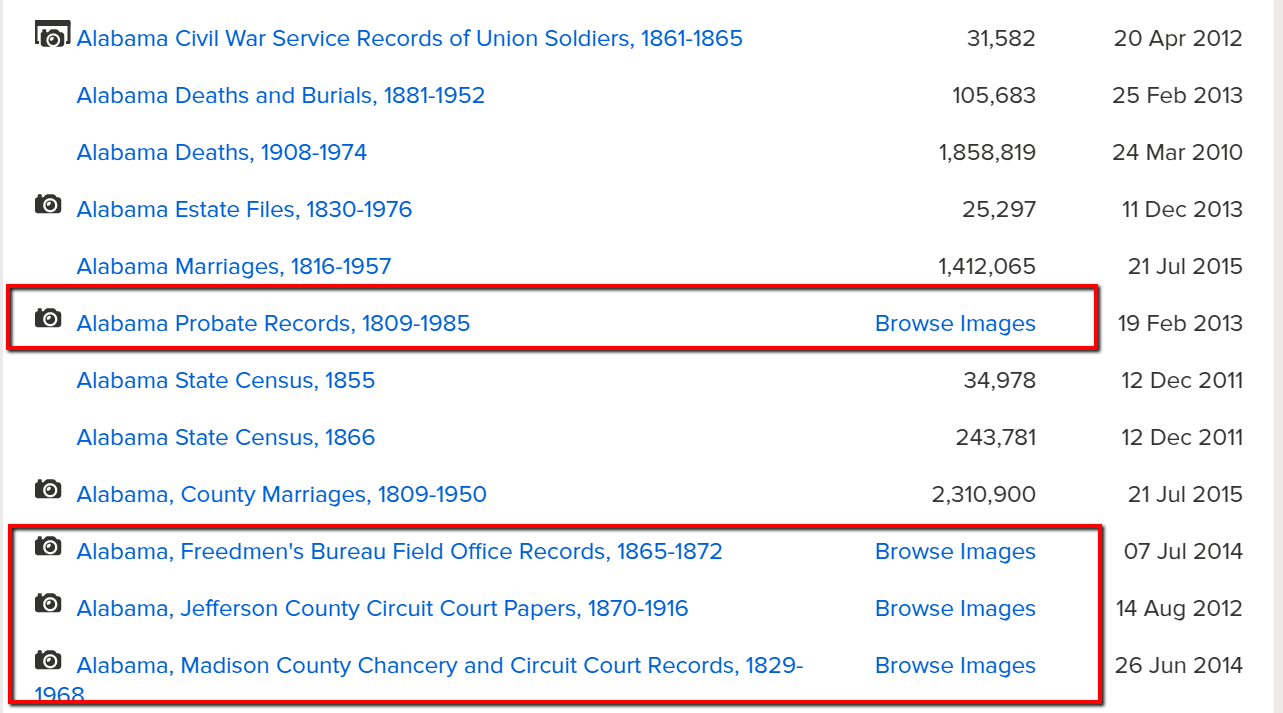
The highlighted genealogy records in these collections are browse-only
You may be thinking, “Good grief! I can’t possibly browse thousands of records!” and we don’t expect you to. In this article we are going to share strategies that you can use to zero in on the genealogy records you want to browse.
Browse Only Records Versus Indexed Records
Most folks search for genealogy records at FamilySearch by typing in some key information at the home page. It might be just the first and last name, and the place where that ancestor lived. Here’s an example:

When you use this method, you are only searching for records that have been indexed.
Indexed records are great because they have already been reviewed by one of the thousands of FamilySearch volunteers. They use online software on the FamilySearch website to download images of historical documents. Then, they read the information on the image and transcribe the information.
A second, more experienced volunteer then reviews the transcribed information to ensure accuracy before it is submitted to the website where they can be searched. It’s a huge effort to help genealogists more easily search the online records.
So, it’s important to understand that not all digitized record images that are on the FamilySearch website have been indexed. This means there may be countless records that will not be retrieved by a name search.
Unindexed records can only be browsed until they are indexed. So as you can see, there is a very good chance that there are records on the site that apply to your family, but you won’t find them through the search engine.
Instead, you need to go in the virtual “back door” to locate these records. Follow along with me and I’ll show you how.
How to Find Browse-Only Records at FamilySearch
Let’s imagine you want to search probate records in Auglaize County, Ohio.
You would click the little map in the vicinity of the United States and choose “Ohio” from the pop-up box.

At the Ohio research page, you could do a general search of the Ohio collections. Again, this is only searching records that have been indexed.
Instead of using this method, scroll down until you see “Ohio Image Only Historical Records.” Look at all these databases you might have missed!
For our example, continue to scroll down until you see the database titled “Ohio Probate Records, 1789-1996” near the bottom. Click on it.
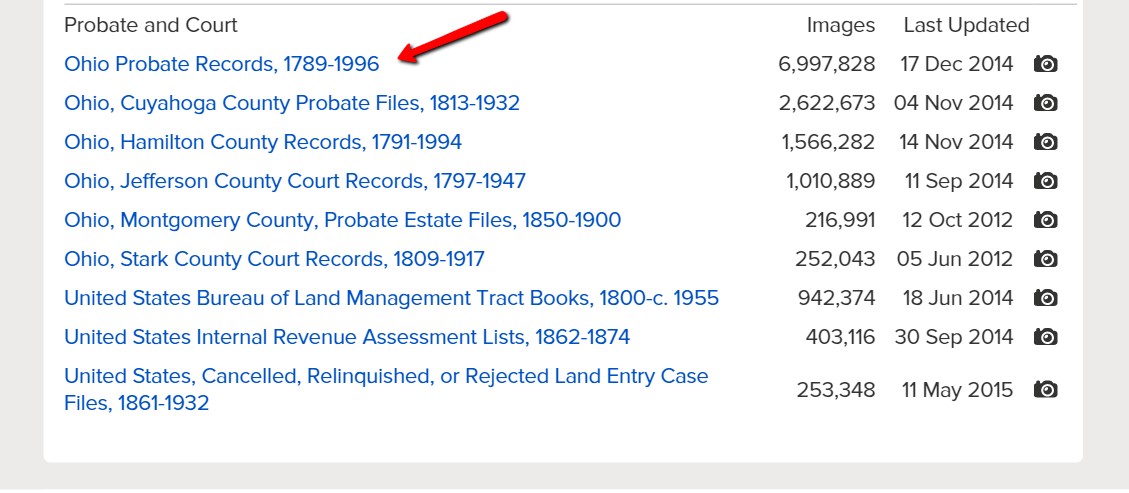
You will notice right away that there is no way to “search” this database.
Many people give up at this point, after all, who has time to search nearly 7,000,000 records. Click on it anyway!
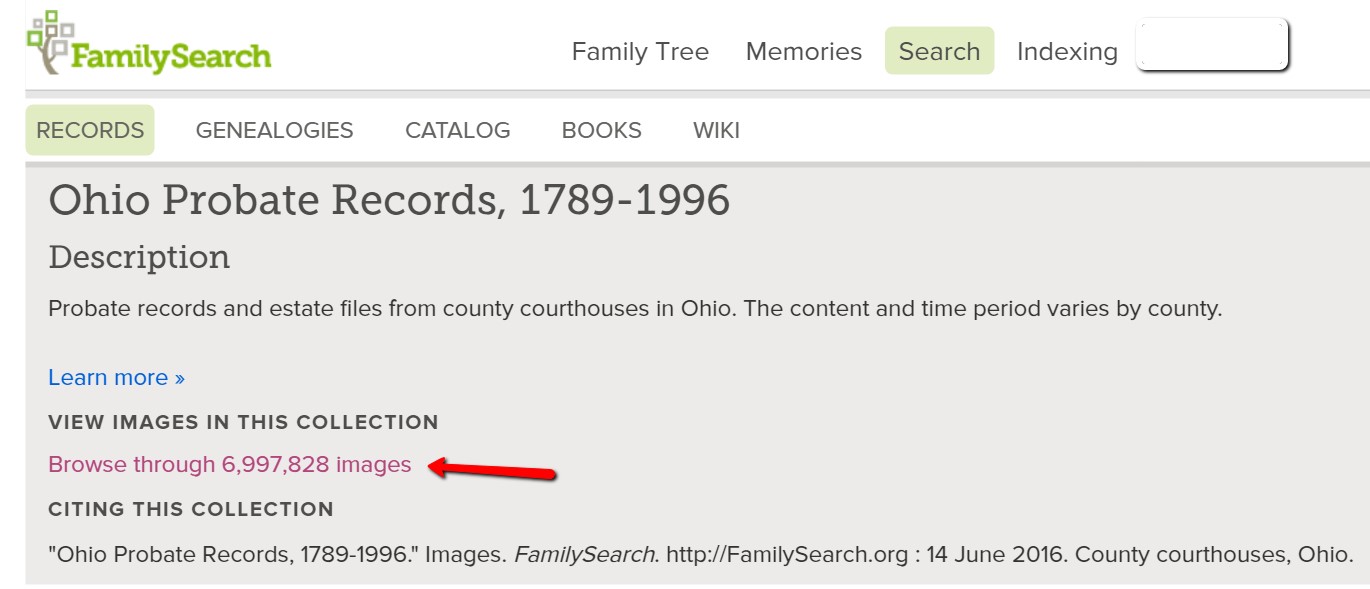
The next screen has been broken down by county name. Choose the desired county name. In this case, I’m selecting “Auglaize.”
You are then directed to a page listing the volumes of records for Auglaize county that have been digitized.
In this example, we are seeing bonds, settlements, wills, estates, and so much more:
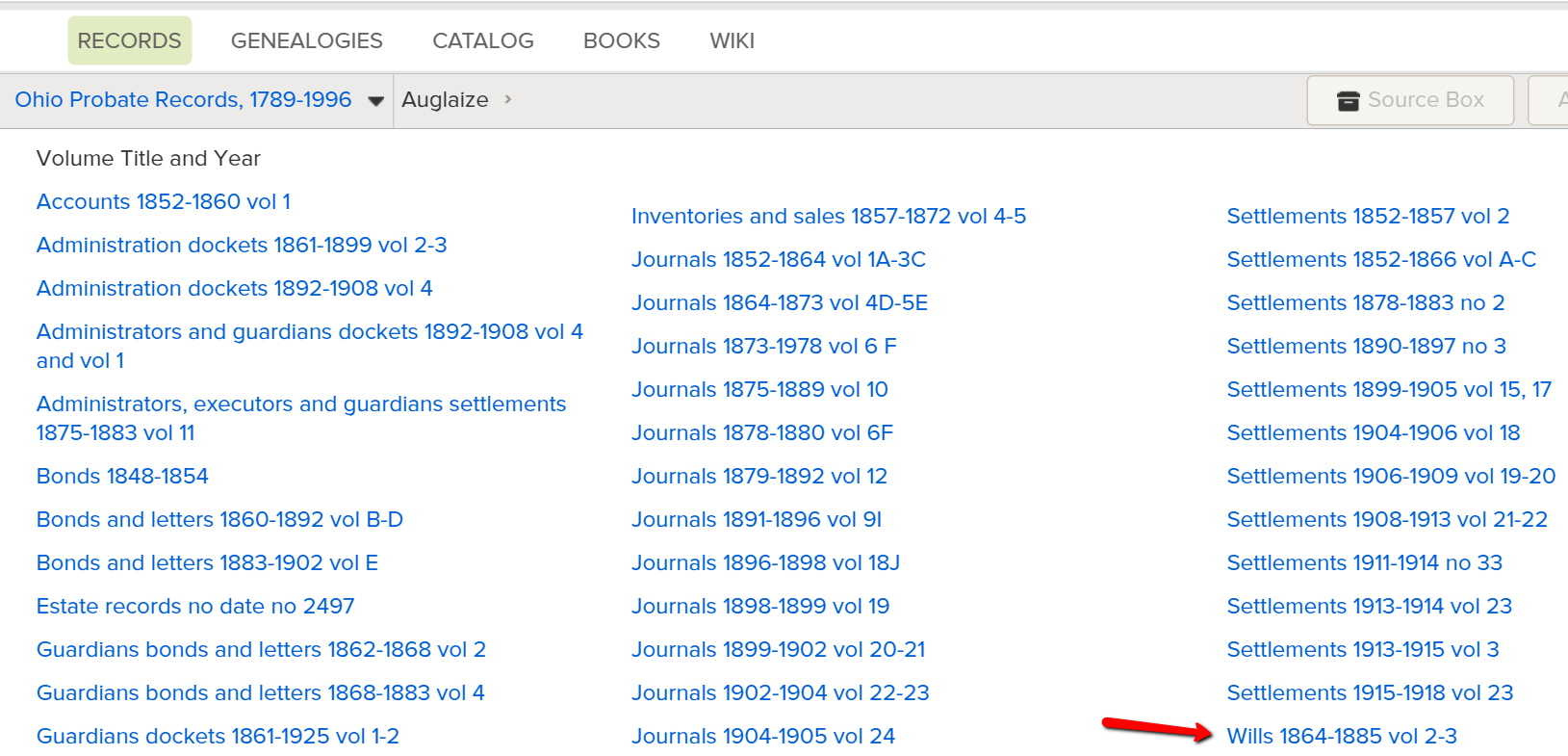
It is as if you are standing in the courthouse probate office surrounded by volumes and volumes of the records you need.
Select the volume you want to search by clicking the title.
“Open” the pages of the book and search like you would as if you were flipping the pages of a book or scrolling through a roll of microfilm.
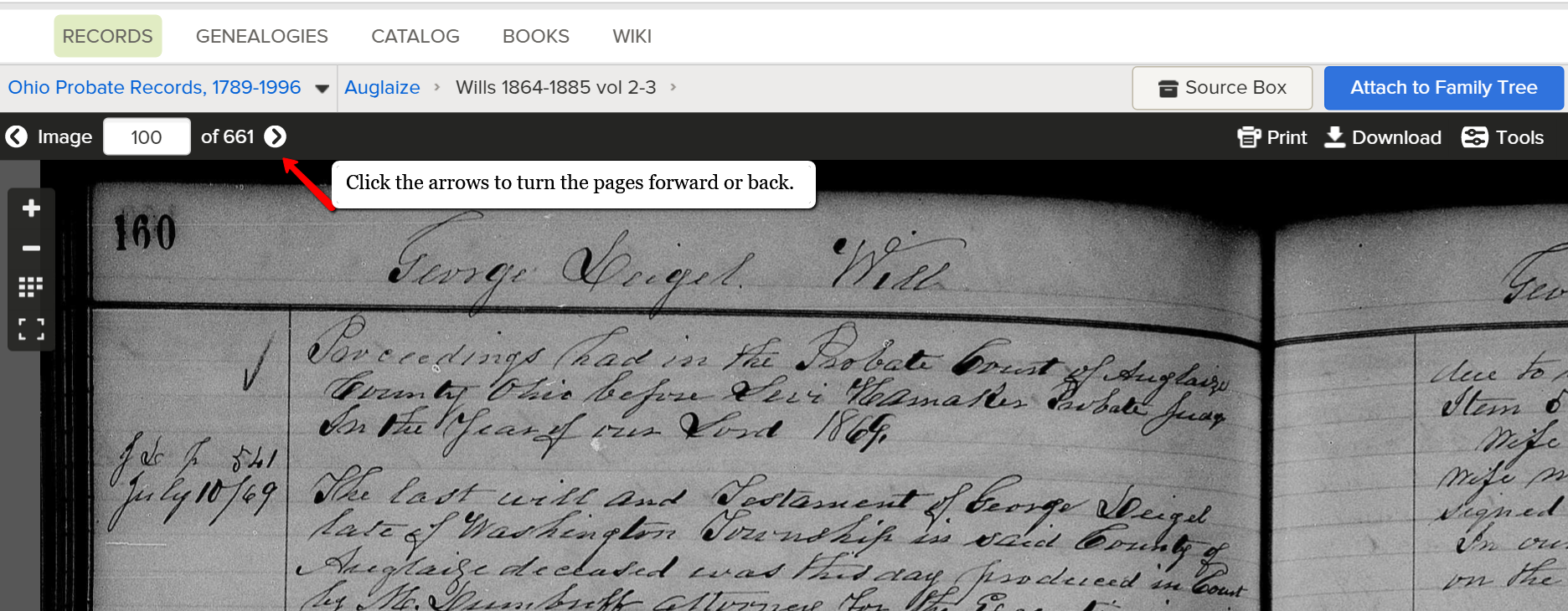
Click the arrow at the top of the screen to scroll through the pages.
Friends, we want you to get excited about all the new records that are coming online, even if they are browse only databases. If you like this tutorial, share this tip with your genie friends so they can do it too.
More Genealogy Gems on Records and Databases at FamilySearch
For more tips and tricks to help you in your genealogy journey, sign-up for our newsletter by entering your email address on this page.
If you’re looking for more genealogy records to mine, here are some of our articles. These will help you not only find new records, but also use other valuable genealogy indexes:
by Lisa Cooke | Oct 4, 2019 | 01 What's New, Land Records |
Land records are some of the most underutilized, yet most useful, records available in genealogy. Often, they are the only records which state a direct relationship between family members. They can also be used to prove relationships indirectly by studying the land laws in force at the time. Sometimes they can even be used to locate an ancestor’s farm or original house, so that we can walk today where our family walked long ago.
Land records exist in the United States in abundance for most locations. Read on to learn how to find land records and how they can help you scale seemingly impossible brick walls in your genealogy research. Our guest blogger is Jaye Drummond, a researcher for Legacy Tree Genealogists.
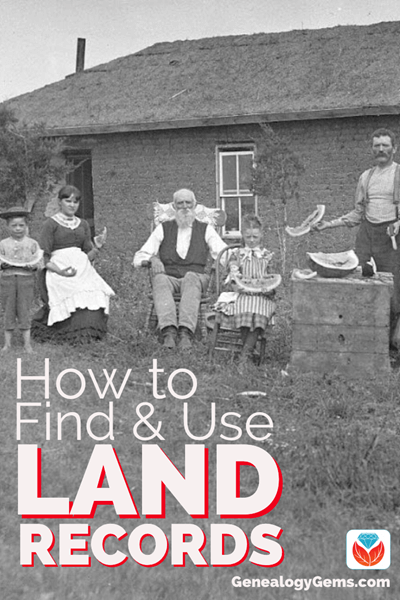
The History of Land Records
The search for new land is one of the main themes of American history, so it makes sense that land records would be an important part of researching that history.
The right to own real estate was not universal in most of the countries from which the majority of American immigrants came. And even when it was possible to own land legally, it was often too expensive and thus out of reach for most people.
As a result, the lure of vast expanses of relatively cheap and plentiful land has proved irresistible to millions of immigrants to American shores over the course of the past 400 years.
The land records created throughout those years to document ownership of all that real estate have accumulated in seemingly limitless amounts. Even in the face of catastrophic record loss in some locations, land records are generally plentiful. They usually exist from the date of formation of colonial, state, and county governments, where the records still exist.
Information Contained in Land Records
Due to the paramount importance of land ownership in what would become the United States, land records often are the only records in which you will find your ancestors mentioned in some areas.
And there’s good news! Land records often state relationships or provide other, indirect, evidence of family relationships. This makes them an invaluable resource for genealogists.
Understanding what kinds of land records exist, where to find them, and how to use them is often critical to solving genealogical mysteries.
4 Types of Land Records and How to Use Them
There are four different types of land records that can play a vital role in your family history research. Let’s take a closer look at what they are and how to use them.
1. Land Deeds
The most essential land record is the deed. Deeds document the transfer or sale of title, or ownership, of a piece of land or other property from one party to another.
Deeds usually concern land, or “real” property, but they also often mention moveable or “chattel” property, such as household goods and even enslaved persons.
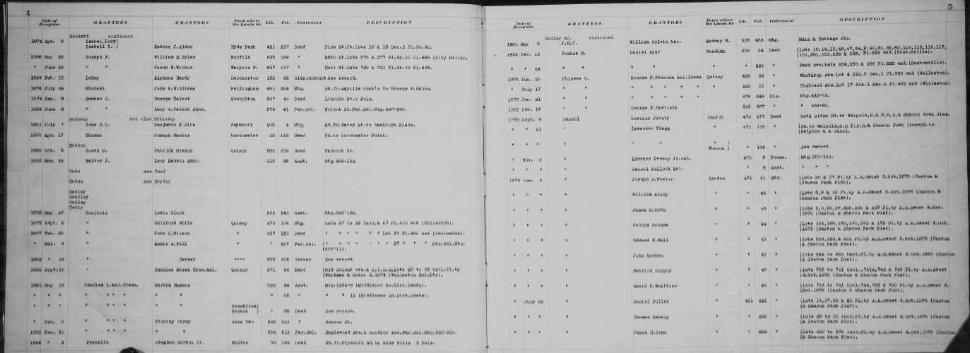
Example of deed index, courtesy of FamilySearch
They sometimes, but not always, contain explicit, direct statements of relationship between family members. Sometimes this can be a parent-child relationship, but deeds can also include a list of people who are children or heirs of a particular deceased person who owned the land being sold.
Sometimes the language in deeds involving heirs makes it clear that the heirs are children, sometimes not, so some care must be taken not to assume that all heirs are children. Research in other records sets such as probate, census, and church records may make the relationships of the heirs to the deceased land owner clearer.
In the early years of a settlement, and sometimes later, deeds books also often contained other types of transactions, including the sale of enslaved persons and sometimes even wills. These are often records for which no other copies survive. Thus, surviving deed books should always be checked for ancestors and their family members in every jurisdiction in which you do genealogy research.
Also, remember to check published abstracts of deeds if they exist, as witnesses to deeds were not included in most indexes to the original deed books. Witnessing a deed was one of many ways relatives assisted one another, and thus the presence of one of your ancestors as a witness for someone else suggests they had some kind of relationship, which might lead to the discovery of previously unknown ancestors.
Also keep in mind that not all states required the recording of deeds throughout their history, or did not require them to be recorded in a timely fashion.
Pennsylvania is an example of this lackadaisical attitude to record keeping that now seems foreign. When researching land records in Pennsylvania it is important to remember that deeds for an ancestor might have been recorded years, even decades, after the actual transaction took place. Therefore, always remember to check the indexes for deeds and other transactions many years after the person in question died or left the area.
In other states, such as New Jersey, land was sold at the colony and state level for longer than is typical in other areas and thus land records must be sought at the state or colony level up to that time.
In the case of New Jersey, deeds only began to be recorded in the various counties around 1785. Therefore, New Jersey real property research must be done at both the county and state or colonial level.
In the case of colonies and states with massive record loss, such as Virginia, land records recorded on the state level are often the only records that survive for some counties, and thus are critical for success in navigating such “burned” counties.
2. Land Grants and Patents
Land grants and patents issued by the various colonial, state and federal governments are also an important resource, including land lotteries in states like Georgia.
In many states, such as Pennsylvania and North Carolina, the original applications, warrants, surveys, and patents or grants still exist and can be searched at the state archives or online.
While these documents do not often state relationships, they sometimes do. That was the case with one of my ancestors whose father had applied for a land patent in Pennsylvania in 1787. He died before the patent was issued in 1800, and thus it was granted to his son by the same name. However, the land patent spelled out that the original applicant had died and his son was the person actually receiving the patent.
Land patents and grants, as well as deeds in general, can also document the dates in which an ancestor resided or at least owned land in a given location. This can assist the researcher in establishing timelines for ancestors. It can also help when it comes to differentiating between two or more individuals residing in a given area with the same name. Anyone dreading research on their Smith and Jones ancestors might just find the solution they seek in those old, musty deed books!
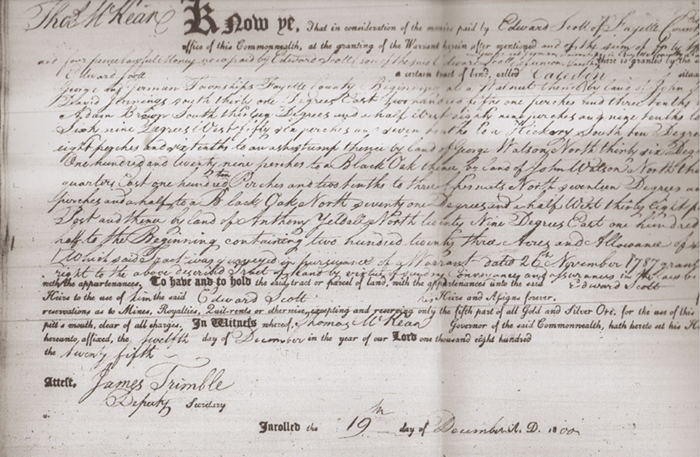
3. Mortgages
Other land records that might prove essential in solving genealogy puzzles are mortgages.
In some states like New Jersey, mortgages were recorded locally earlier than deeds and sometimes survive for earlier years than do deeds.
A mortgage is a promise by a borrower to repay a loan using real estate as collateral—in effect deeding title to the real estate to the creditor if the loan is not repaid.
A similar instrument called a deed of trust, or trust deed, performs the same function with the exception that a third-party trustee takes title if the loan is not paid back in full. In the early years, mortgages and trust deeds were usually contracted with private individuals, but as the banking industry grew in the United States over the course of the nineteenth century, they began to be taken out with banks instead of private persons.
The two parties involved in a mortgage are the “mortgagor” and the “mortgagee.” Indexes can often be found for mortgages using those terms.
However, sometimes early mortgages and trust deeds were recorded in the same books as deeds, so keep an eye out for them.
And remember: the mortgagor is the borrower, while the mortgagee is the creditor.
Don’t be put off by their sometimes-confusing terminology. Old mortgages and trust deeds are some of the most underused land records in existence—yet they can sometimes be the key that unlocks the door to that next ancestor. Don’t overlook them!
4. Tax Records
One other land record that could crack the case is land tax records. Everyone who owned land had to pay taxes on it, at least in theory. Sometimes, land tax books include notations about one person inheriting land from another, or more commonly, the change in owner’s name from one year to the next can indicate inheritance of the land. The absence of a deed or will showing the transfer might be explained by checking the land tax books.

“14th Dec. 1786 Received of Mr. James Brooks Six pounds, Eighteen Shillings and four pence in full for the balance of Samuel Wood Estate Land Tax for 1784 & Half tax for 85.” John Rodes L. Ds. Image courtesy of MyHeritage.
The Law of the Land: Primogeniture and Genealogy
In some cases, the inheritance and real estate laws of the time might allow you to make a determination of parentage even without a will or deed stating the suspected relationship.
The legal concept of primogeniture, or inheritance of land by the first-born son, was in force in many parts of the Thirteen Colonies until soon after independence, especially in the southern and middle colonies. Thus, when a land owner died, his first-born son would often inherit all or most of his land if he died intestate, or without a will.
The emergence of one man as the owner of a given piece of land in place of the previous owner, either as the seller, or “grantor,” in a deed or in the land tax records, could indicate that the previous owner died and the land was inherited by his “heir-at-law,” the first-born son. There might not be any record of this transfer, so knowing the “law of the land” can prove to be instrumental in cracking the case.
In these and many other ways, land records can be used to find direct and indirect evidence of family and other types of relationships, often when no other record does—or even survives. It is for this reason that land records research must be part of any reasonably exhaustive genealogical investigation.
Where to Find Land Records
In some areas, land records are the only records that survive which state relationships or can be used to provide indirect evidence of them.
They also are useful in establishing biographical timelines for ancestors, and to learn more about their lives. They can sometimes also be used to identify the location of ancestor’s farms and sometimes even their original homes, so that today’s genealogists can often literally walk in the footsteps of their ancestors. But where are those records now?
It used to be that if you wanted to do genealogy the right way, one of your first stops had to be at the county courthouse where your ancestors lived. This is still a good practice, as many treasures held within the walls of the hundreds of courthouses scattered across this land are not microfilmed, digitized, or abstracted, and likely never will be.
The Recorder of Deeds and the County Clerk are therefore often the genealogist’s best friends. So, planning a trip to the courthouse or archive where land records are held is still a good idea.
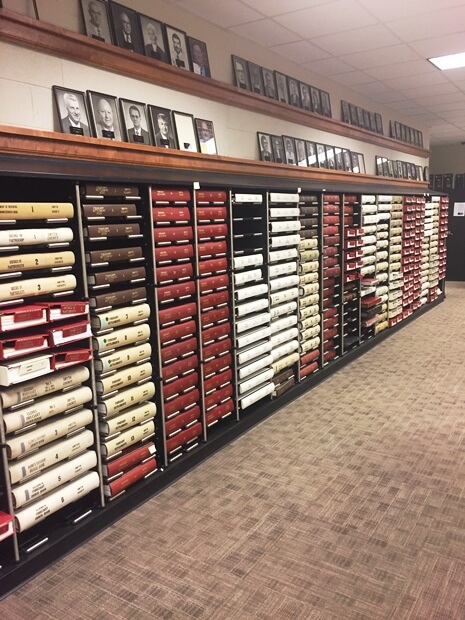
Smyth County, VA courthouse records (Image credit: Margaret Linford.)
But many of us live far away from where our ancestors owned land and lived out their lives. How can we access these records if we don’t have the time or budget to travel to the areas in question?
Thankfully, the digital revolution has made researching land records and other types of documents much easier, but often still time consuming and at times overwhelming.
The land records held at the state level for “state land” states (the original thirteen colonies and the states formed from them such as Maine and Kentucky) are usually indexed. They can often be accessed digitally at the website for the state archives, commercial genealogy sites such as Ancestry.com, or can be ordered via correspondence with the archive.
In states that were part of the old Northwest Territory, such as Ohio and Indiana, as well as the other public land states (any state formed under the Constitution that was not carved out of one of the original colonies), grants from the federal government to the first recorded owner of that land can be found at the Government Land Office site created by the Bureau of Land Management. Their website (available here) allows searches for names of individuals who purchased federal land in public land states. You can even view the digital images of the land grants, including the signature of the President of the United States at the time.

Example of a land patent image.
Other types of records associated with federal land, include:
- applications for public domain land grants,
- Homestead Act applications,
- Freedman’s Bureau land records,
- and bounty land warrants and applications for veterans.
These are all held at the National Archives in Washington, D.C. Many of these records also state relationships and add rich detail about the lives of ancestors. However, most of these records have never been digitized and must be searched in person or requested via the National Archives’ online order service.
(Editor’s note: Learn more about land records at the National Archives here.)
Land records at the county or town level are still held at the local county courthouse or archive, if they survive. Many jurisdictions have digitized their land records and made them available online, in many cases for free. This can sometimes include the entire run of a county’s land records, back to the formation of the county. County clerks and recorders will also sometimes do research via correspondence, though most are unable to do so due to time constraints.
Land Records at FamilySearch
Most importantly in the field of land records research from a genealogical perspective is the massive digitization project undertaken by FamilySearch, the website for the genealogical Society of Utah.
Millions of land records from all across the United States, and even some from other countries, are available at their website free of charge—and viewable either from the comfort of your own home or at a Family History Center or the Family History Library itself, depending on the license agreement FamilySearch has with the original repository.
This vast trove of land records is almost completely unindexed by FamilySearch and will thus not appear in results using their “Records” search page. They must instead be searched in the “Catalog” search page. (Editor’s note: learn how to search unindexed records at FamilySearch by reading our article: Browse-Only Databases at FamilySearch are Easy to Use.)
Despite not being indexed by FamilySearch, the digitized microfilms themselves usually have indexes, either in separate volumes or at the beginnings or ends of the digitized individual deed books.
Most of the digitized land records made available by FamilySearch date from 1900 or before, so a trip to the courthouse might still be warranted for most twentieth-century deeds and more recent land records research. If all else fails, don’t forget to ask the recorder or clerk for help if you have a limited research goal, such as one deed copy—you just might be surprised how eager and willing they are to help.
If the land records you need are unavailable online or are held in a remote location, consider hiring a professional genealogist to go to the courthouse in person on your behalf. Legacy Tree Genealogists has a worldwide network of onsite researchers who can obtain nearly any record that still exists in most areas. Learn more here about how we can assist you in the search for your ancestors and the records of their sometimes only tangible piece of the American dream—land!
(Editor’s note: Our links to Legacy Tree Genealogists are affiliate links and we’ll be compensated – at no cost to you – if you use it when you visit their website. This page includes a discount code for full service projects, or scroll to the bottom of the page for information about their 45-minute genealogy consultations. Thank you for helping to keep our articles and the Genealogy Gems Podcast free. )
Indeed, land ownership was more widespread in the Thirteen Colonies and the United States than most any other nation on earth. So the good news is that there’s a good chance that some of your ancestors were land owners. However you access them, land records are absolutely critical for success in genealogy and should be thoroughly examined whenever possible. You’ll be glad you did.
Jaye Drummond is a researcher for Legacy Tree Genealogists, a worldwide genealogy research firm with extensive expertise in breaking through genealogy brick walls. To learn more about Legacy Tree services and its research team, visit their website here.
by Lisa Cooke | Oct 15, 2015 | 01 What's New, Adoption, African-American, DNA, Health History
Two cousins recently chatted after learning that they share DNA. The first asked whether the second is white. “No,” she answered. The response: “Are you sure?”
In our modern society, families are defined in a myriad of different ways. Using DNA for genealogy is certainly contributing to these
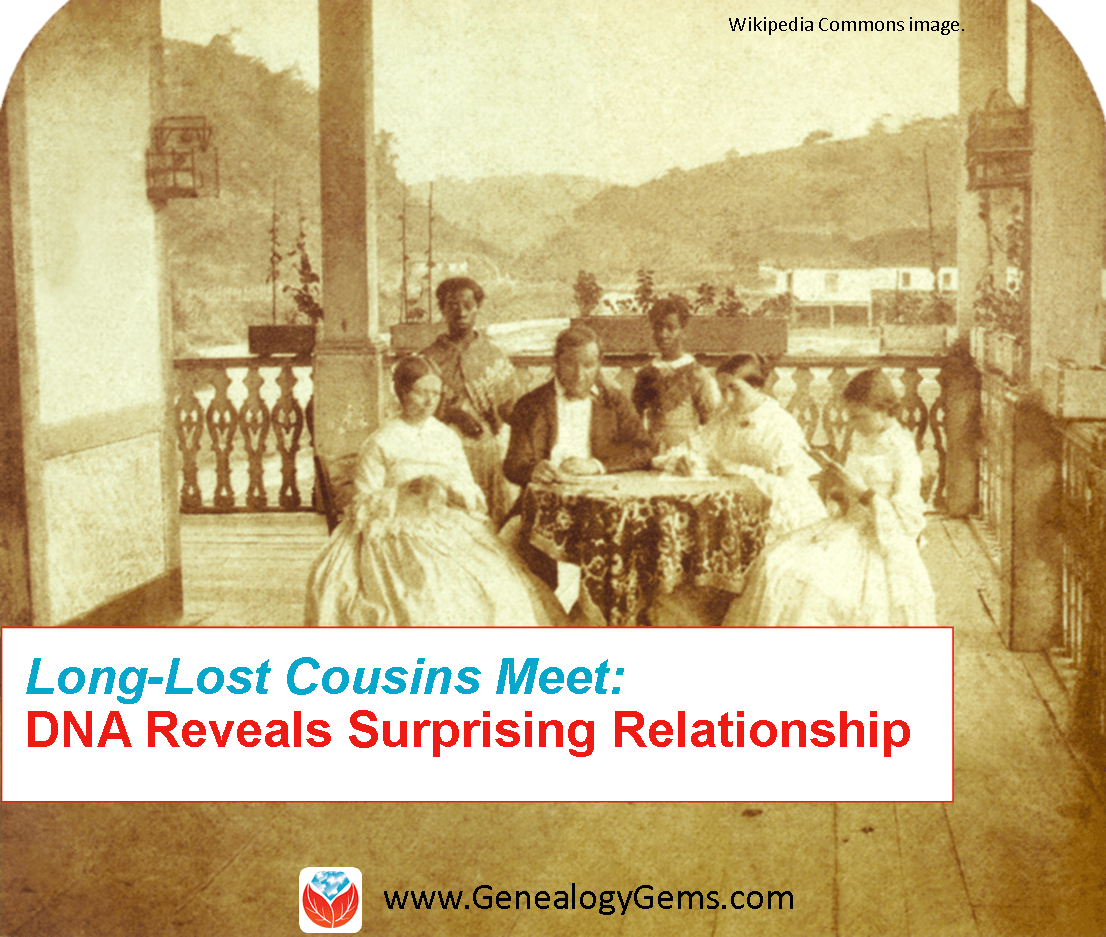
A family and its female slave house servants in Brazil, c.1860. Wikimedia Commons image. Click to view full source citation.
changing definitions, as families find themselves genetically linked across social and cultural boundaries to kin they never expected.
Such is the case for a Bartow, Florida resident who submitted a DNA test out of curiosity and found more than she expected. Through a combination of DNA testing and social media, Mary McPherson, who is white, met one of her cousins, Dolores Washington-Fleming, who is black.
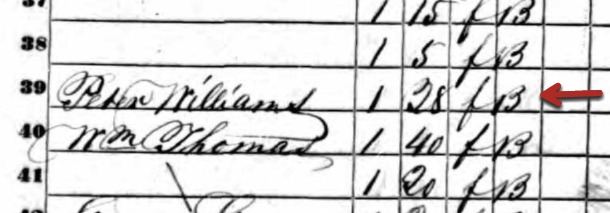
Peter Williams’ entry in 1850 U.S. Census Slave Schedule, St Bartholomews Parish, Colleton, South Carolina. Image from Ancestry.com.
According to an article on The Ledger, the two women share a great-great-grandfather, Peter Edward Williams, who was born in South Carolina two centuries ago. Peter was a slaveholder. The 1850 census slave schedule shows that he held a female slave who was a few years younger than she was. Dolores believes that’s her grandmother’s grandmother.
The two finally met this past May for the first time and enjoyed this new definition of family. I think what I like most is what Dolores’ son said about the situation: “My mom and I are fascinated by history, and this is history. We represent what the times were like back then.” It still boggles my mind just a little that we are able to use the DNA of living people today to resurrect the past, and bring depth and meaning to the present, and possibly even prepare us for the future.
I find myself in a similar situation to Dolores and Mary. My mom was adopted, and even though we have had DNA testing completed for several years, we didn’t have any close matches, and honestly, we weren’t looking. Though she did have a passing interest in her health history, my mom did not feel the need to seek out her biological family. But then over the last few months various pieces of her puzzle have started to fall into place. This is much because of a key DNA match that popped up in March.
With that one match and subsequent correspondence, our interest in my mom’s biological family has skyrocketed. Why? I think it is because our DNA match, sisters from Texas, have shown us genuine kindness and interest. They have truly shown us what it means to be family. Even though we are unexpected, even though we aren’t sure yet how exactly we are connected, they have embraced us without reservation without hesitation.
To me, this is what family is. They accept you in whatever condition you come in and do their best to make you feel like you belong. Now, that kind of welcome isn’t felt by everyone who meets their genetic cousins, and people should carefully consider whether they’re ready for unforeseen results or unanticipated reactions from DNA matches before they get started.
But what about you? If you’ve started down the genetics path, how has DNA testing expanded or strengthened your definition of family?
Learn more about DNA testing for genealogy–how to get started or how to make sense of testing you’ve already had–with my quick guides available at the Genealogy Gems store, and then contact me at YourDNAGuide.com to arrange your own personal DNA consultation.
Resources for DNA for Genealogy
DNA Quick Guides for Genealogy (Bundle them for savings!): Getting Started, Autosomal DNA, Y Chromosome DNA, Mitochondrial DNA, Understanding Ancestry,  Understanding Family Tree DNA
Understanding Family Tree DNA
New AncestryDNA Common Matches Tool: Love It!
Confused by Your AncestryDNA Matches?
 Thank you for sharing this article with others by email or on your favorite social media site. You’re a gem!
Thank you for sharing this article with others by email or on your favorite social media site. You’re a gem!

















 Understanding Family Tree DNA
Understanding Family Tree DNA Thank you for sharing this article with others by email or on your favorite social media site.
Thank you for sharing this article with others by email or on your favorite social media site.